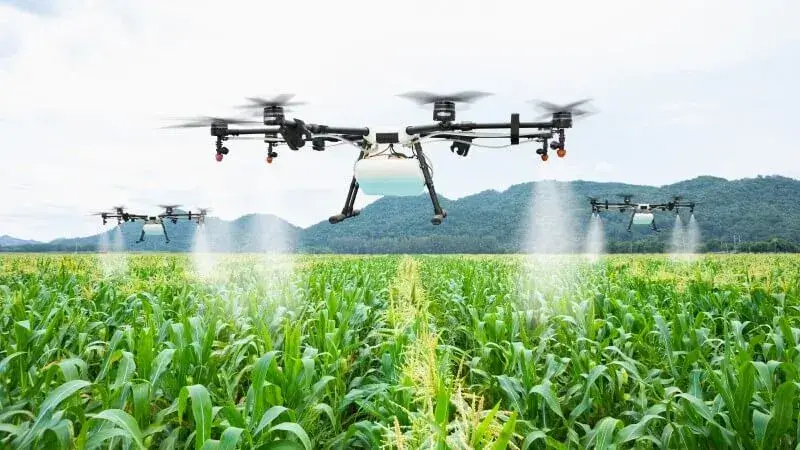Drones have emerged as a transformative technology in modern agriculture, revolutionizing farming practices and offering a pathway to enhanced efficiency and sustainability. Known as Unmanned Aerial Vehicles (UAVs), drones are increasingly being used in precision agriculture to monitor crops, analyze soil, manage irrigation, and control pests. Their ability to provide aerial views and collect real-time data enables farmers to make informed decisions, leading to better productivity, reduced costs, and more sustainable agricultural practices.
Current Applications of Drones in Agriculture
- Crop Monitoring: Drones equipped with high-resolution cameras and sensors capture detailed images of fields, providing valuable insights into crop health, growth patterns, and potential issues such as pest infestations or disease. Multispectral and thermal sensors can monitor crop health, detect diseases, and assess plant growth.
- Soil and Field Analysis: Before planting, drones create detailed 3D maps to analyze soil health, moisture levels, and nutrient distribution, aiding in better planning and resource management.
- Precision Spraying: Drones can spray pesticides and fertilizers more evenly and precisely than traditional methods, reducing the amount of chemicals needed and minimizing human exposure to harmful substances. Precision application reduces chemical usage by applying chemicals only to the areas needed. AI-driven systems adjust spray rates based on crop needs and field conditions.
- Irrigation Management: By identifying areas of the field that are too dry or too wet, drones help farmers optimize irrigation and conserve water.
- Planting: Some drones can plant seeds by shooting them into the soil with compressed air, which is especially useful in difficult-to-reach or hazardous areas.
- Yield Estimation: AI-powered image analysis provides accurate yield predictions, aiding in harvest planning.
- Livestock Monitoring: Drones can monitor livestock, ensuring their well-being and safety.
Benefits of Drones in Precision Agriculture
- Increased Efficiency: Drones can cover large fields quickly, performing tasks like spraying and monitoring in a fraction of the time it takes using traditional methods.
- Precision Agriculture: Drones use sensors and GPS technology to apply fertilizers and pesticides with pinpoint accuracy, reducing waste and environmental impact.
- Cost Reduction: Long-term savings from reduced labor and input costs can be substantial, even though the initial investment in drone technology can be high.
- Environmental Impact: Drones help reduce the overuse of chemicals and water, contributing to more sustainable farming practices.
- Improved Accuracy: Drones provide precise data and images, allowing farmers to make more informed decisions, ensuring that resources are used effectively, reducing waste, and improving crop quality.
- Sustainability: Drones promote more sustainable farming practices by reducing chemical usage, optimizing irrigation, and providing insights into soil health, which contributes to healthier ecosystems and a reduced environmental impact.
- Reduced Chemical Usage: Targeted chemical application reduces the overuse of pesticides and fertilizers, which can have harmful effects on the environment, contributing to more sustainable and eco-friendly farming practices.
Challenges and Solutions
Despite the numerous benefits, several challenges hinder the widespread adoption of drones in agriculture:
- Regulatory Compliance: Navigating the legal frameworks and regulations surrounding drone usage can be complex.
- Data Management: Handling and interpreting the large volumes of data collected by drones requires robust data management systems.
- Initial Investment Costs: The upfront costs of purchasing drones and related equipment can be a barrier for some farmers.
- Technical Expertise: Operating and maintaining drones requires skilled operators and technical expertise.
- Connectivity Issues: Insufficient internet access, especially in rural areas, impedes the widespread adoption of precision agriculture techniques.
To overcome challenges, comprehensive implementation plans are necessary, encompassing measures such as promoting local drone manufacturing, supporting drone service providers, revising regulations, providing operator training, fostering an enabling ecosystem for entrepreneurs, conducting research on drone applications, and integrating drones into existing extension systems and custom hiring centers. Government initiatives and policies also play a crucial role in facilitating the use of drones in agriculture through subsidies, legal frameworks, training programs, and awareness campaigns.
Drones are transforming precision agriculture by providing farmers with powerful tools to monitor, manage, and optimize their fields. The benefits of increased efficiency, cost savings, and environmental sustainability make drones an invaluable asset in modern farming. As technology continues to advance, the role of drones in agriculture will only grow, paving the way for a more productive and sustainable future in farming.

















